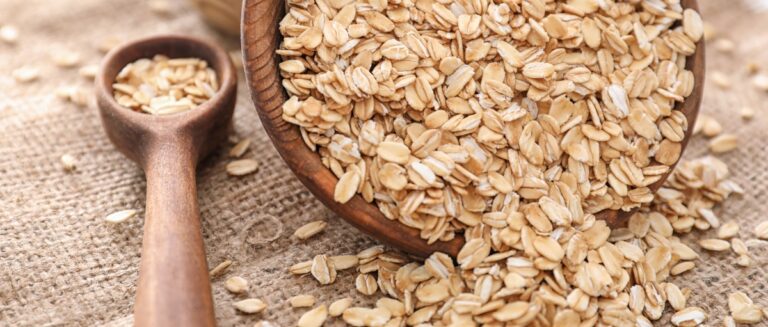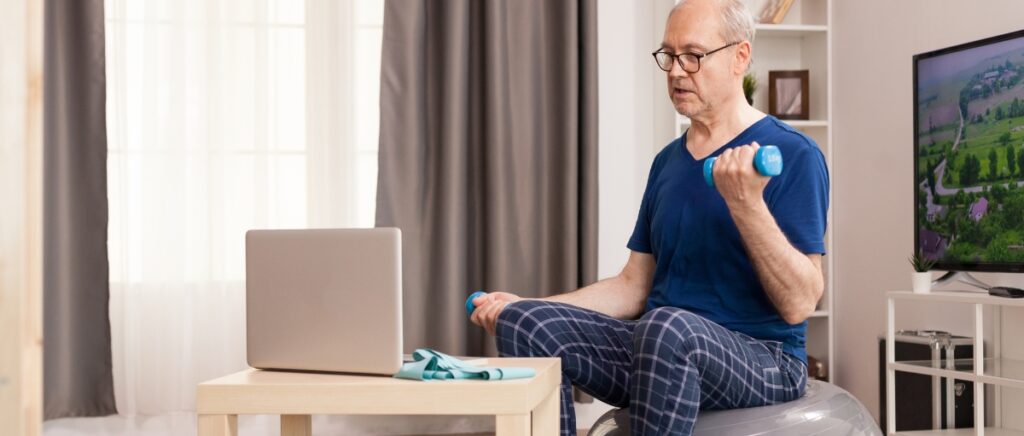According to the CDC, only 28% of adults over 50 meet the recommended weekly amounts of physical activity. And that percentage drops even lower (26%) for those over 75. But it’s never too late to prioritize your health and well-being. With online exercise classes tailored specifically for seniors, getting fit and reaping the benefits of regular physical activity is easier and more convenient than ever before.
Experts advise that seniors strive for 150 minutes (2.5 hours) of moderate exercise each week, including strengthening exercises at least twice a week and balance activities. While that may sound daunting, online workouts make meeting these goals easy without leaving your living room.
Online exercise classes offer a variety of workouts tailored to different fitness levels, allowing seniors to improve strength, flexibility, and balance from the comfort of home. Whether you’re looking to ease into exercise or maintain an active lifestyle, these virtual options make it simple to stay healthy and engaged at any age.
The Remarkable Benefits of Exercise for Seniors
You’ve likely heard that exercise is good for you. But did you know just how beneficial it is, especially as you age? Regular physical activity offers many advantages for older adults, supporting both physical and mental well-being. Let’s take a closer look at some of the most impressive ways exercise can improve your health and quality of life.
Physical Health Benefits
- Increases strength and endurance: Engaging in exercises that target your major muscle groups, like resistance band workouts or bodyweight movements, helps build and maintain lean muscle mass. This increased strength makes everyday activities easier, boosts your metabolism, and lowers your risk of injury.
- Improves flexibility and balance: Workouts that focus on stretching, such as yoga or pilates, can significantly enhance your flexibility and range of motion, allowing you to move more freely and comfortably. Balance-specific training, like tai chi, helps prevent falls, a major concern for many seniors.
- Reduces risk of chronic diseases: Studies show that regular exercise lowers the risk of developing several chronic conditions, including:
- Heart disease
- Stroke
- Type 2 diabetes
- Some types of cancer
- Obesity
Even if you already have a chronic illness, staying active can help you manage symptoms and improve your overall health.
- Eases pain and stiffness: Gentle exercise can relieve arthritis or other conditions that cause pain and stiffness. Low-impact exercise can also increase the production of hormones that help reduce inflammation.
Mental and Cognitive Benefits
- Boosts mood and reduces stress: Exercise releases endorphins, the body’s natural “feel-good” chemicals. These can lift your spirits, ease anxiety or depression, and promote a general sense of well-being. Plus, taking time to focus on physical activity can be a great stress reliever.
- Provides social engagement: While many online workouts can be done solo, some offer a sense of community through live classes, virtual challenges, or online forums. Connecting with others who share your fitness goals can provide motivation, accountability, and a sense of belonging – all important factors for mental health.
- Improves sleep quality: Struggling to get a good night’s rest? Regular exercise can help. Physical activity during the day leads to more restorative sleep at night. Just be sure not to exercise too close to bedtime, as this may leave you feeling energized and make it harder to drift off.
- Supports brain health: Exercise doesn’t just strengthen your muscles; it also gives your brain a workout. Engaging in physical activity can:
- Improve memory and cognitive function
- Slow age-related mental decline
- Reduce the risk of dementia and Alzheimer’s disease
Aerobic exercises that increase your heart rate are especially beneficial for brain health. They increase blood flow and brain irrigation and support the improvement of neuronal plasticity.
The evidence is clear. Exercise is a powerful tool for promoting healthy aging. With so many options for online workouts designed specifically for seniors, it’s never been easier to reap these remarkable benefits from the comfort of home.
Exercising Safely as a Senior
Starting a new workout routine can feel intimidating, especially if you’re an older adult with health concerns or limited mobility. But the good news is, there are plenty of ways to reap the benefits of exercise while staying safe and comfortable. Here’s what you need to know to embark on your fitness journey confidently.
Consult with Your Doctor
Before diving into any new exercise program, it’s crucial to get the green light from your healthcare provider. This is especially important if you have a chronic condition, like heart disease or diabetes, or if you’re taking medications that may affect your ability to exercise.
During your consultation, be sure to:
- Discuss any health concerns or limitations you have.
- Ask about specific exercises or types of workouts that may be most appropriate for you.
- Find out if there are any activities you should avoid or modify based on your individual needs.
Your doctor can provide personalized guidance to help you create a safe, effective workout plan.
General Safety Tips
Once you’ve gotten the okay from your doctor, keep these general safety tips in mind as you get started:
- Start slowly and gradually increase intensity: If you’re new to exercise or haven’t been active, begin with short, low-intensity workouts and slowly build up over time. This helps prevent injury and allows your body to adapt to the new demands you’re placing on it.
- Warm-up and cool-down: Dedicating just 5-10 minutes to gentle warm-up and cool-down exercises can significantly prevent muscle soreness and injury. Start with light walking or marching in place, then do dynamic stretches before your main workout. Finish with a few minutes of static stretching to help your muscles relax and recover.
- Listen to your body: While mild discomfort is normal when starting a new exercise routine, pain is not. If something hurts or doesn’t feel right, stop and rest. Pushing through pain can lead to injury and setbacks. Remember, the goal is to challenge yourself gradually, not overdo it.
- Stay hydrated: Drinking plenty of water before, during, and after workouts is essential for regulating body temperature, maintaining joint lubrication, and preventing fatigue. Keep a water bottle handy and take sips throughout your exercise session.
Exercising Safely at Home
One of the many benefits of online workouts is the ability to exercise in the comfort and privacy of your own home. To ensure a safe and effective home workout experience:
- Create a designated exercise space: Choose enough room to move freely and clear away tripping hazards like loose rugs or cords. If you’re using a chair or other props for support, ensure they’re sturdy and stable.
- Wear appropriate clothing and footwear: Opt for breathable, comfortable clothing that allows you to move easily. Supportive, well-fitting sneakers are a must to protect your feet and joints, and prevent slips or falls.
- Keep a phone nearby: While the risk of injury during exercise is low, it’s always better to be safe than sorry. Keep a phone within reach in case you need to call for assistance.
Remember, listening to your body and respecting your limits is the key to a successful fitness journey. With a little preparation and caution, you can safely enjoy all the benefits exercise has to offer.
Discover the 7 Best Online Exercise Classes for Seniors
With so many online workout options available, it can be overwhelming to know where to start. To help you narrow your choices, we’ve curated a list of some of the best free and subscription-based resources designed specifically for older adults.
4 Free Online Exercise Programs
- Senior Fitness with Meredith: This popular channel offers various workouts for seniors of all fitness levels, including chair exercises, strength training, balance, and flexibility. Meredith’s engaging teaching style and clear instructions make her videos easy to follow.
- Grow Young Fitness: Certified senior fitness instructors Deron and Debra offer a range of low-impact workouts on their YouTube channel, focusing on functional movements and fall prevention. They also provide modifications for different abilities and helpful tips for staying motivated.
- HASfit: While not exclusively for seniors, HASfit offers a variety of low-impact, beginner-friendly workouts on its website and YouTube channel. You can filter workouts by length, intensity, and equipment needed, making it easy to find a routine that suits your needs.
- The National Institute on Aging (NIA): The NIA website features free workout videos and exercise guides designed for older adults. The routines focus on endurance, strength, balance, and flexibility, as well as tips for staying active with chronic conditions.
3 Subscription-Based Programs and Apps
- SilverSneakers: If you have a Medicare Advantage or Medicare Supplement plan, you may be eligible for free access to SilverSneakers, a fitness program for seniors. Members can access live online classes, on-demand workout videos, and a nationwide network of gyms and community centers.
- AARP Virtual Community Center: Through the organization’s Virtual Community Center, AARP members can access various live and on-demand fitness classes for seniors. Classes range from gentle yoga and tai chi to strength training and dance, with new options added regularly.
- Mighty Health: Mighty Health is a wellness app for adults over 50. It offers personalized fitness and nutrition plans, daily workouts, and one-on-one coaching. The app tailors your program to your specific goals and fitness level and provides accountability to help you stay on track.
Choosing the Right Online Exercises for Your Needs
With so many options available, how do you choose the best online workouts? Consider these three key factors:
- Current fitness level and physical limitations: Be honest about your starting point and any challenges you face. Look for workouts that offer modifications for different abilities, and be bold and start with beginner-level classes and work your way up.
- Personal fitness goals: What do you hope to achieve through exercise? Whether you want to build strength, improve balance, or simply maintain your fitness level, choose workouts that align with your objectives.
- Class format and instructor style: Do you prefer fast-paced, high-energy workouts or slower, more mindful practices? Look for classes and instructors that resonate with your personality and learning style. Be bold and try a few different options until you find a good fit.
Taking the First Step Toward a Healthier You
Starting an exercise routine can feel overwhelming, but with the wealth of online resources available, it’s easier than ever to get moving and reap the benefits of regular physical activity. By choosing workouts that align with your fitness level, goals, and preferences, you’ll be well on your way to a healthier, happier you.
With so many options available, finding a routine that fits your lifestyle and feels enjoyable is important. Whether it’s low-impact exercises, yoga, or strength training, plenty of online classes tailored to seniors focus on gentle movements, balance, and flexibility. This variety allows you to choose something that resonates with you, keeping you motivated and engaged as you build a regular habit.
Remember, the most important thing is to start somewhere and be consistent.
Even small amounts of exercise can significantly affect your overall health and well-being. So why not take that first step today? Explore some of the online workout options we’ve shared, find an interesting class, and try it. Your mind and body will thank you.
Sources
Centers for Disease Control and Prevention (CDC). (2023). Adults aged 50 and older: Physical activity guidelines and reports. Retrieved from https://www.cdc.gov/physical-activity/php/reports/adults-50-and-older.html
Centers for Disease Control and Prevention (CDC). (n.d.). What counts as physical activity for older adults? Retrieved from https://www.cdc.gov/physical-activity-basics/adding-older-adults/what-counts.html
Open Access Government. (2023). Preventing chronic diseases through physical activity. Retrieved from https://www.openaccessgovernment.org/prevent-chronic-diseases/128895/
Harvard Health Publishing. (2023). Easy ways to keep inflammation in check. Retrieved from https://www.health.harvard.edu/staying-healthy/easy-ways-to-keep-inflammation-in-check
Khan, K. A., & Siddiqui, S. (2022). The role of physical activity in preventing chronic diseases. Journal of Aging and Health, 15(4), 324-333. Retrieved from https://www.ncbi.nlm.nih.gov/pmc/articles/PMC9256523/











